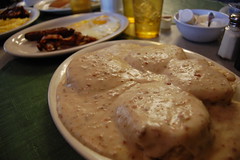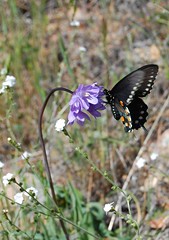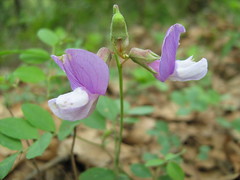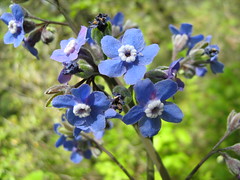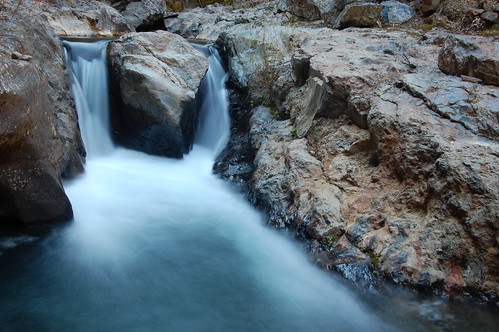
Spring is the ideal time to hike in the foothills of the Sierra Nevada, a historic gold mining area. So for this April weekend, I searched for good hikes in the region, and ended up on the the Bureau of Land Management's website for South Yuba Trail and Campground, where I downloaded a map and planned out my hike. Having seen a beautiful photo of Malakoff Diggins for sale the previous weekend at the visitor center for South Yuba River State Park, I selected that as the destination of the hike. It turns out that my friend Erik was able to make it, so I picked him up Sunday morning and headed to Gold Country.
Highway 49 skirts around the beautiful old gold mining town of Nevada City, forcing you to make a left-hand turn at a light, where straight ahead is CA 20. Very soon you come to another light and North Bloomfield Road. After a while, North Bloomfield Road narrows and gets rougher, and then it descends to the South Yuba River, where there is an old bridge with a wooden deck. On the other side of the deck, the road is gravel. A short distance on this road takes you to South Yuba Campground, where camping is only $5 per night.
We parked in the parking lot for day users above the campground, and started out. The trail initially parallels the campground road, until reaching the main trailhead. It was a brisk morning, and the whole area we were hiking in at the beginning was in shade, so I kept a jacket on.
I didn't have high expectations from this hike. It is not mentioned in my hiking books. I just knew that we would have an opportunity to see some of the wildflowers of the foothills, and that this is a hike best done before it gets hot (unless you plan to go swimming), as it is at low elevation.
But right away we saw promising signs. The wildflowers were there, alright, as we spotted a shrub with bright yellow flowers (Scotch broom?) and and several tiny little blue flowers with white centers right near the trailhead. And we were barely started when we came across Kennebec Creek and a sign for a waterfall. Rounding a corner, we found the stream flowing across a smooth section of granite, with a small horsetail waterfall above it, and a few clumps of tiny pink flowers on the banks of the creek below.

After the obligatory photos, we started off and immediately encountered some deep red flowers. Soon the trail joined an old road grade from gold mining days, which heads down to Illinois Crossing. Erik kept pointing out plants that he thought looked like poison oak here. Some people do not develop a rash even if they rub against poison oak. Me, I am very sensitive to it, and don't even need to touch it. The oil that causes rashes can be borne on the wind. I've resigned myself to the fact that I'm going to get poison oak and itch for three weeks, and I don't worry about it (although I still try to avoid touching anything that vaguely resembles the descriptions I have read).
We followed the old road grade only as far as the junction where South Yuba Trail turns off of it to run parallel to the South Yuba River along the north wall of the canyon formed by the river. There were small ups and downs, but the trail is not too challenging, and it is clear and relatively smooth. It might make for a challenging bike ride (bicyclists are allowed on it), but it's easy for hiking. We encountered many more types of wildflowers. Only one was in great abundance, covering large swaths in this area just where the trail begins to follow the river, but there were small clumps of different varieties here and there. Occasionally we could glimpse the river below, seeing bits of white water and emerald pools. Usually we could see the south wall of the canyon, covered with intermixed conifers and deciduous trees.

At 1 1/2 miles out we encountered the sign for Overlook Point Picnic Site. We found the picnic tables, but not much of an overlook. Perhaps the vegetation has cut off a view that the area used to have thirty years ago. Along with names, carved in one of the picnic tables was the year 1978, with moss growing in the depression of the carving. Around this area we started to take note of one type of flowering chaparral, fully decked out with small purplish pink flowers, possibly western redbud.

Dudleya
When we reached Long Point, we had our most spectacular view of the river and its canyon. At this point the river swings to the north on a large horseshoe bend, and the south canyon wall protrudes in a smooth curve further softened by the lush vegetation. Unfortunately, we were on the north side of the canyon looking south, giving poor lighting for a photograph.

I don't recall if it is right before this, or right after, but a spur trail down to river is very near here, labeled North Canyon Spur. The signage there indicates that it is 3 miles from the trailhead at South Yuba Campground. We pushed on and as the river continued to rise in elevation as we hiked upstream, we finally descended to just above it at the junction with Humbug Trail, 4 1/2 miles out from the campground, where there are two picnic tables, and the second best view of the river on the portion of the South Yuba Trail we covered.
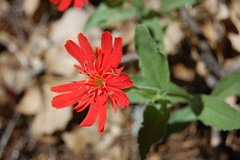
The mercifully short initial portion of Humbug Trail is extremely steep. We huffed and puffed, and right at the top of it found the same deep red flowers we had seen early on the hike, only in better lighting, which made for a good excuse to stop for a moment. The rest of the trail wasn't that bad, but it was certainly more difficult than South Yuba Trail, and required a bit of scrambling over rocks now and then.
Humbug Trail follows Humbug Creek, named in response to the disappointment of gold miners who were led to believe they would get rich there. Initially the creek is far below the trail, but as we hiked upstream it got closer to the trail, and we began to see many fine small waterfalls. Where it was easy to get down to the creek at a particularly rich area of them, we stopped to take some photos. There are old and rusted iron rods coming out of the granite there, no doubt remains from the gold rush.

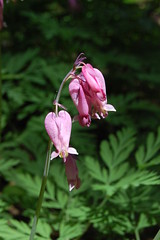
Erik wanted to attempt to cross the creek here, for a better view of some falls below, but I thought it would be best for us to continue on and see all there was to see, before deciding on what was worth spending time going off trail for. So we kept going.
Then we reached a totally unexpected delight, a massive tiered waterfall, with a final plunge of about 25 feet. Humbug Creek Falls, it is, as we found out later from a sign we saw at the end of the trail. I had no idea we would see anything like that.
Above the falls, Humbug Trail enters a more subdued region of forest, without the steep canyon walls, and the creek farther distant. We crossed two small tributary streams, one dry, and the other just a trickle, and passed above a campground. Finally, we came to a gravel road and the trailhead, the start of Humbug Trail for most people, although the end for us. Judging from the map I figured if we turned right and headed east on the road we should soon find a trail over to Malakoff Diggins.
That turned out to be the case. Specifically, we ran into a sign explaining the North Bloomfield Drain Tunnel, a 7,874-foot tunnel 200 feet below. A creek flowing here across orangish mud--orange from all the iron in it--drops down into the tunnel through an old shaft. Another sign here indicated that the trail alongside it provided access to Malakoff Diggins.
We were soon upon them. The diggins are the strangely beautiful aftermath of massive environmental destruction in quest of gold. This was not the romantic scene of thousands of gold miner venturing west, clambering down steep canyon walls and staking claims in the hopes of a finding enough gold to provide them with a comfortable life. This was the work of a massive industry financed by major financiers, designed by engineers, and carried out by legions of low-paid workers.
The walls of the canyon were washed away with high pressure hoses, exposing more and more ore to be processed for gold, and sending dirt and debris downstream in massive amounts. This killed off the fish in the creeks and rivers, and put so much silt in the system downstream that towns had to build high levee walls to contain rivers with ever rising beds. The town of Marysville, built along the banks of the Yuba River near where it flows into the Feather River, now sits below the level of the river, protected from it by a massive levee. Out in the countryside, crops were frequently damaged from floods resulting from all the sediment and tailings washing downstream.
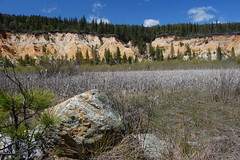
Malakoff Diggins
It was this very mine that was the subject of the landmark court decision in 1884 in the case of Woodruff v. North Bloomfield Mining and Gravel Company that would eventually put an end to hydraulic mining in California, although it took many years to fully enforce it. In all the time since, nature has made progress in reclaiming this area, but the massive scar along the edge of the park, caused by work that started more than a century before I was born, will long outlive me.
In all, we hiked about 7 1/2 miles from the campground to Malakoff Diggins. We could have taken a shortcut back, following North Bloomfield Road. But, of course, we wanted to photograph the waterfalls, and I wanted to see some of the different sights along the way in different light.
When we got back to the big waterfall, we took a small side trail over to a granite area between the two tiers of it. We were right at the plunge pool for the smaller upper falls, and on the verge of the larger lower falls. I laid myself out on granite and stuck my camera out to take a photo over the edge.
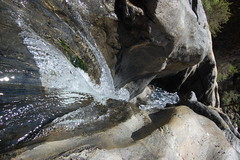
The Edge of Humbug Creek Falls
Back on the trail, I could see that it would be possible to get to the base of it via a scramble down the canyon wall for the best photos. But I thought maybe farther down the trail we might have easier access to the creek, and be able to work our way upstream to it. I did find a place where the scramble was easier, and we went to the creek. But I found huge boulders here blocked the view of the falls, and I couldn't find a way to get far enough upstream for that view from there. So I scrambled straight up to the trail again, which left me winded. It was getting to be quite a long and tiring hike, so I didn't have the energy to go back and try the more difficult scramble.
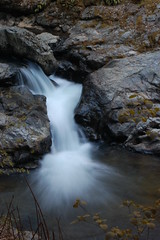
Instead we went down trail. At one point there is view of a fine series of small falls. I took a long exposure here, using my backpack as a tripod (I stupidly forgot my Gorillapod in the trunk of the car). Erik wanted to scramble down here and take more shots, but I was too exhausted, so I went ahead and took more long exposures of other small waterfalls.

It took Erik a while to catch up to me. He told me that he had been obsessing over some dudleya. As I left him, I saw him paying attention to more dudleya. When I got back to the very steep initial portion of Humbug Trail, I stopped just above it to wait for Erik, who must have once again have found himself obsessed with dudleya. But if something more serious was holding him up, like an injury, I didn't want to have to reclimb that steep portion to look for him, which is why I waited until I saw him before starting down it. Shortly before he appeared, I heard bird noises that vaguely reminded me of turkeys, but they were coming from up in the trees behind me. I was reminded of John Muir's descriptions of all that you can hear and see if you stay still and quiet in the wilderness for a while, and let its denizens return to their daily routine. Erik's approach silenced my unseen companion.
Back on South Yuba Trail we met two mountain bikers at picnic tables. Other than a couple we passed in both directions on Humbug Trail, these were the only people we had seen all day. Later we would encounter one more person, a man jogging past us in the opposite direction.
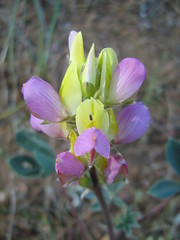
Other than more stops for wildflowers on the way back, the highlight was an encounter with a rattlesnake. I saw him up ahead on the trail and thought I would quickly sneak up on him so I could get a good photograph. Thinking on it now, I recall the advice I have read about rattlesnakes--to make lots of noise with your footsteps so that they have plenty of warning and will get out of the way before you can startle them. Quickly sneaking up on a rattlesnake is the last thing you want to do. He was startled and took off while rattling at the same time. I got a lousy photo.
I thought he might have taken off entirely, but as I continued forward, he started rattling again. He was in the rocks at the edge of trail, taking cover. I just kept walking and he stopped rattling. When Erik came along I warned him that there was an angry rattlesnake in the rocks that would rattle at him as he passed. He kept asking me "Where?" I kept repeating "In the rocks," while pointing at a pile of rocks. Erik seemed quite nervous and when the snake started to rattle he momentarily stopped and looked to the side. I told him to keep moving, and soon he was past and the snake stopped his noisemaking.
Being on fairly easy trail again, we were able to recover and make better time than I expected coming back, which allowed the leisure of a few more wildflower photographs. I waited for Erik at a split in the trail at the end--one way leading back to the campground, the other leading to the parking for day users. While waiting I heard rustling, and looked down to see a quivering mouse trying to burrow under leaves to hide from me. When it was finally out of sight the rustling stopped.
Despite making better time on the final portion than I expected, it still took us a full 8 1/2 hours to complete the hike. Even though it was a cool day, I went through all of the water I brought with me.
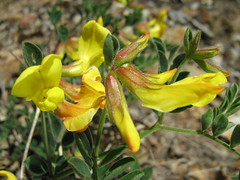
Today, the day after, my legs don't feel too bad. Erik was right about the poison oak, however. I've already developed rashes in several areas, and my past experience leads me to believe it is going to get a lot worse as the week goes along.
